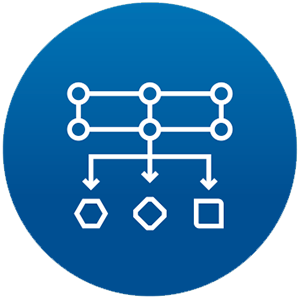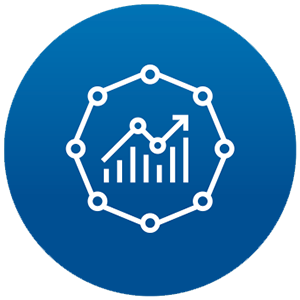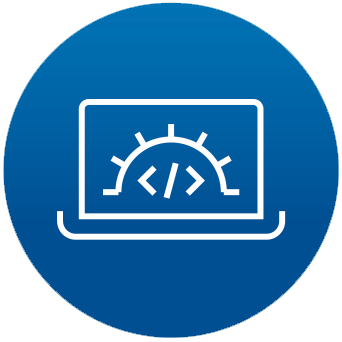
Our Domains Provide Guidance on Key
Performance Indicators and Pathways
We acknowledge the importance of the individual subjects and embrace them by giving context and highlighting the relationships and interconnections between six key domains.

RESPONSIBLE IMPACT
Technologies and innovations that drive positive impact for society at large
Goals
• Offset the impact on the planet in the categories of ESG (Environmental, Social and
Governmental)
• Level the playing field through: Sustainability/Circularity, Diversity/Inclusion, Climate,
Openness, Ethics
Approach
Six prime and measurable maturity characteristics represent the ability to achieve Responsible Impact:
1. Goal Setting
2. Scalability
3. Replicability
4. Socially-responsible business model/strategy
5. Measurable
6. Traceable to a UN SDG (United Nations Sustainability Development Goals)
Benefits
• Improved operational efficiencies across the board
• Visibility as a global leader in responsible computing
• Compliance with legislation, governance standards and evolving cultural norms

RESPONSIBLE DATA CENTER
Data centers designed and operated with an emphasis on sustainability
Goals
• Reduce environmental impact with more efficient strategy and design
• Migrate to renewable energy sources
• Monitor consumption and carbon footprint
• Optimize re-use of waste from cooling and production
• Strive to be net zero by 2030 in compliance with UN SDGs
Approach
• Reducing energy consumption with accurate measurements
• Strategizing for technology refreshes
• Implementing renewable energy sources
• Identifying cooling considerations based on location
• Focusing on cooling, power, distribution, UPS service, generators, cables and racks with emphasis on use and re-use of materials
Benefits
• Increased operational efficiency with environmental considerations
• Reduced energy consumption
• Decreased CO2 emissions
• Less reliance on rare metals and toxic materials

RESPONSIBLE INFRASTRUCTURE
Efficient use of available and future technology
Goals
• Realize greater efficiencies with infrastructure designed to deliver high-performing
sustainable operations
• Consolidate workloads that peak at different times to compliment each other and increase
efficient use of resources
• Obtain high levels of utilization (which can be improved by consolidation) to deliver more
efficient use of energy and resources
Approach
• Establish a baseline measurement on energy usage and material/asset lifecycle
• Improve analysis and reporting based on experience and established baseline
• Request each IT infrastructure vendor to provide information and reports on energy usage
and product lifecycle
Benefits
• Savings in physical space
• Reduced waste and consumption
• Manage ESG impact of the hardware, software and networks required to develop, test,
deliver, monitor, control and support IT services
• Consolidation and rationalization that enables individuals and organizations to have
a positive impact on the world

RESPONSIBLE DATA USAGE
Data that is securely used in ways that drive transparency, fairness and respect for the users
Goals
• Certify that the data used, processes and people are trusted and high quality
• Reduce errors and misinterpretation of data from manual handling by deploying intelligent
workflows
• Remain competitive and nimbly respond to quality data while embracing innovation from
applying artificial intelligence and machine learning
Approach
• More robust policies, guidelines and practices for the governance of data (e.g., maintaining
lineage and explain-ability)
• Ongoing data usage risk-assessment and risk mitigation with responsible computing in mind
• Managing the lifecycle of data with accountable data-retention and destruction practices
Incident response and data breach remediation
Benefits
• Minimal errors in the data that could lead lead to financial losses, wrong executive decisions
or destroy the integrity of individuals, enterprises or even markets
• Effective and efficient use of data
• Heightened collaboration between the business and IT

RESPONSIBLE SYSTEMS
Inclusive systems that address bias and discrimination driving equality for all
Goals
• Ensure the “systems” employ an integrated set of technologies to provide a service to human beings. It can be composed of hardware, data, code, models and services
• Build systems that are ethical, privacy-preserving, secure and resilient. Systems will be
designed with the environment, individuals, society and the future taken into consideration
in IT decisions
Approach
Responsible Systems are designed with a 3 layered approach:
1. A cultural ethos across the entire supporting organization
2. The use of forensic technology that can monitor, detect issues to enable trust
3. Governance requirements to which the entire organization adheres
Benefits
• Maintaining integrity of internal systems
• Achieving compliance with internal and external standards
• Ongoing monitoring to ensure companies develop and use responsible systems
• Reinforced corporate social responsibility and closing the digital divide

RESPONSIBLE CODE
Conscious code choices that optimize environmental, social and economic impact over time
Goals
• Align teams on software architecture, technology, programming language and platform
• Anticipate and monitor the total costs of running, supporting and maintaining applications
• Balance the trade-off between accuracy, speed and cost, including energy consumption
of systems
• Address the hidden energy impact of code
• Reduce data duplication and improve cyber security
Approach
• Implement sustainability maturity assessment tools and KPIs to accelerate decision-making and pinpoint areas requiring more scrutiny during software development
• Utilize tools and methods to apply to develop applications more responsibly
• Heighten team awareness by setting up on-going training and workshops to reinforce shared sustainability goals
Benefits
• Conscious design choices reflecting accessibility, energy consumption and economic
sustainability
• Improved cybersecurity
• Increased awareness of the responsibility that comes with writing code and the impacts
on users’ lives and the planet
• Expose the hidden energy impact of code and decreasing the digital divide
test
test
